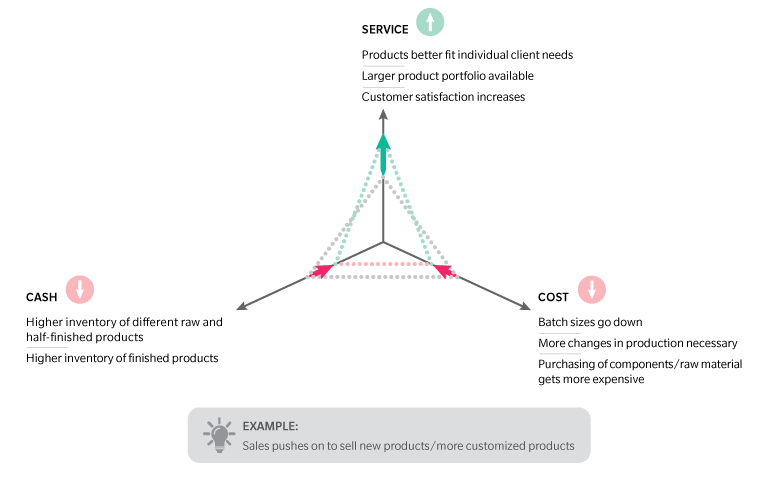Supply chain management often faces substantial pressure, as it is called upon to achieve multiple goals simultaneously. It is seen as an auxiliary function to other departments: sales demand high service levels to keep up with increasing customer demands regarding speed; finance requires supply chain to cut costs; and production likes to produce in large batch sizes to increase asset utilization, implying higher stock levels and costs. In such a setup, balancing requirements is challenging. To oil the supply chain wheels, an explicit supply chain strategy and data-driven transparency are beneficial for finding the right balance between these contradictory requirements. In the manufacturing industry, a company can be a product leader, a service leader, or a cost leader, but it cannot shine in all three areas at the same time.
Many manufacturers are plagued by a multipronged quandary: low service/delivery performance, coupled with high costs and/or high levels of tied-up working capital. Solving for the dilemma is a task that typically falls to the supply chain management function, which is often seen as an auxiliary function and is called upon to do the impossible: balance the opposing aims of the various departments, including sales, manufacturing, and finance. Those goals, in short, can be summarized as delivering higher service levels and lower costs while freeing up cash.
But maximizing service levels while simultaneously minimizing costs and capital employed is a difficult undertaking, given their diametrically opposed nature: Higher service levels are typically accompanied by higher costs, whereas reducing costs and capital employed places pressure on service levels. The effort puts undue pressures on supply chain managers, hindering them from focusing on the activities that matter most in their work: demand forecasting; inventory control; monitoring of risk; and scheduling of replenishments, to name just a few.
Supply chain management leaders face a challenge in seeking to satisfy these conflicting objectives. Too often, the supply chain function tries to focus on everything—cost leadership, working capital leadership, and service leadership—without prioritizing. And as a result, it fails to focus on anything.
Adding to the problem is that companies themselves often do not fully understand where the pressures are coming from. Typically, these are companies that have been growing steadily and have been focused on their core competencies, which may be strong sales and customer service or highly efficient and low-cost manufacturing. Supply chain management has thus not been an area of focus: the function has grown organically but without much direction of its own, and management has typically viewed it as an auxiliary function, and not as one that has its own perspective. They recognize a problem exists somewhere in the supply chain but don’t really know what to do about it. Too often, they are basing their actions/reactions on the internal struggles between the functions. As a result, they view the frictions arising from the supply chain triangle as temporary, rather than the outcome of a fundamental conflict between competing goals.
Too often, the supply chain function tries to focus on everything—cost leadership, working capital leadership, and service leadership—without prioritizing
Overcoming the pressure on supply chain management, while succeeding in an ever more competitive market environment, requires solid groundwork, such as tying supply chain principles to company goals and budgets and achieving end-to-end transparency along the overall supply chain. In the short-term, it may be necessary for the supply chain function to compromise and follow targets not fully in line with the overall strategic direction. However, in the long term, it is key to focus on supply chain principles that are laid down in a general strategy.Understanding the triangle of critical supply chain interdependencies
The pressure on the supply chain function comes from the absence of clear and coherent supply chain principles. To understand how this stress comes about, it’s important to first look at the three areas that make up the triangle of critical supply chain interdependencies:
- Service levels: Delivering goods and services to the customer in keeping with the 7 R’s of logistics – right product, right customer, right quantity, right condition, right place, right time, right cost. This can be achieved by, for instance, enlarging the distribution network, storing goods at closer proximity to customer locations, or by increasing inventory to ensure that products are available during demand peaks.
- Costs: Supply chains incur costs in various categories, such as the cost of raw materials (purchasing cost), manufacturing, logistics, and warehousing. Cutting costs means, for example, reducing warehouse infrastructure or slowing the frequency of shipments. Both measures can interfere with customer service levels requirements.
- Cash: To function well, many supply chains have to tie up significant amounts of working capital. Typically, the locking up of cash takes the form of holding inventory (whether of raw materials, semi-finished, or finished goods). Maintaining inventory is necessary for several reasons, ranging from required minimum order quantities to lacking supply chain synchronization across companies. Also, the level of accounts payable and accounts receivable has significant impact on the cash situation.
The Supply Chain Triangle — Interdependency between Service, Cost, and Cash
The pressure on supply chain managers is intensified as a result of the contradictory targets of major stakeholders—manufacturing, purchasing, finance, and sales functions—within the organization:
- Manufacturing seeks to produce goods at the lowest possible cost. This can be achieved by increasing batch sizes to minimize setup times and, thus, optimize machine utilization. However, larger batch sizes imply more cycle stock, which in turn locks up capital.
- Purchasing seeks to pay minimal prices to suppliers. To reduce prices, suppliers can cut costs through larger manufacturing batch sizes and/or cutting inventory. But these large batch sizes are not only difficult for customers handling massive inbound goods, but they also reduce the supplier’s flexibility in managing fluctuating demand and fulfilling orders.
- Finance seeks to minimize costs. This puts pressure on the objective of maximizing service levels, a goal that can be achieved by increasing shipment frequency plus investing into infrastructure and inventory levels, amongst other measures.
- Sales aims at satisfying customer demand. This leads to demanding high service levels and new product developments, as well as holding spare parts for aftersales business. This contradicts the goal to minimize cost.
Supply chain principles as basis for overcoming contradicting targets
To reduce the pressure on supply chain management, companies need to define a supply chain strategy, with targets for the entire organization. This strategy must not be set up independently, but instead needs to be a fully embedded aspect of the overall corporate strategy. Here are four steps manufacturing firms ought to take:
- Define the value proposition of the company: The value proposition specifies the overall supply chain targets, which can roughly be split into best product, best solution, and cost leadership.
- Derive the corresponding supply chain strategy: Based on the company’s value proposition (whether it be making the best products, offering the best service, or being the lowest-cost producer), develop the supply chain strategy and define target KPIs.
- Align the targets: To set up targets that are reflected in budgets and bonuses, the company’s strengths and weaknesses need to be analyzed and the effects of targets on service, costs, and cash need to be understood. These targets not only need to be achievable, they must also allow for successful strategy implementation.
- Differentiate between strategic, tactical, and operational measures: In the medium and short term, tactical and operational supply chain targets may deviate from the long-term strategy. For example, a cost leader that is generally lean on inventory may need to increase inventory for a product during a promotion to guarantee availability; strategic, tactical, and operational supply chain targets need to be differentiated.
Steps to overcome the pressure
Conclusion
Supply chain management faces considerable pressures, caught as it is between achieving multiple goals concurrently. Given the auxiliary status of the function, it’s expected to meet the goals of many different masters: the sales department demands that the highest service levels be provided in order to satisfy customers; the finance department requires that the supply chain cut costs; and manufacturing function wants to produce in large quantities to increase utilization.
Satisfying all three masters is a prescription for failure. To reduce those burdens on supply chain management, a company must define the areas in which it wants to excel and, on a strategic level, find a balance between seemingly contradictory demands. This balance and its trade-offs, of course, need to be reviewed regularly and be aligned with changing requirements, as well as communicated to the involved functions. A company can be a product leader, a service leader, or a cost leader, but it cannot be all three at the same time. The organization must make an educated decision and choose which area it wants to focus on—otherwise it won’t be a leader in any of these key areas.



